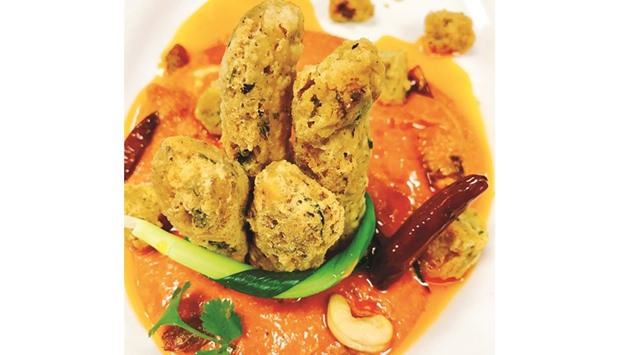Every cuisine has its own impressions of what food is about. Rajasthani cuisine is a true royal cuisine in its ingredients and the final dishes. Rajasthan’s warfare-oriented Rajput community and trading Marwari community both have their own sets of dishes.
Primarily vegetarian, the cuisine of Rajasthan offers a variety of mouth-watering delicacies. The spice level is quite high as compared to other Indian cuisines, but the food is absolutely delicious, helped by a generous drizzling of desi ghee on top.
I came to experience Rajasthani cuisine while I was heading a luxury hotel in Udaipur, also known as the city of lakes. Once you experience Rajasthani cuisine, you cannot forget the sublime intricacy of flavours that will whirl around your taste buds.
I have also experienced a local Rajasthani village-themed resort where men with colourful turbans greet you, help you wash your hands, and then serve you with traditional delicacies of Rajasthan, while you sit down on floor and enjoy a lavish meal. This resort is always hustling with tourists and comes alive at night. It is brightly illuminated and recreates a typical Rajasthani village scene. Dancers and other performing artistes give a taste of the colourful rustic life of the state, while tourists enjoy the mesmerising confluence of music, dance and various delicacies.
Just like every cuisine is influenced by the climate of the place it originates from, Rajasthani cuisine too is influenced by the natural climate of the Rajasthan desert. There is scarcity of water, so there is always a scarcity of fresh vegetables in the region. The people ended up using milk-based products like butter and milk in larger quantities to minimise the quantity of water used in cooking. Dried lentils and beans from native plants like sangria are used extensively in preparation of Rajasthani dishes. Gram flour is another major ingredient used in this cuisine. Popadums are compulsory accompaniments with any meal and made from a variety of flours, but the most popular one is made from corn. The best known dishes in Rajasthani cuisine are the “Gatte Ki Subzi” and “Dal Bati Churma”. Rajasthanis are also fond of spicy dips called chutneys that go with their food. Chutneys are prepared using coriander, mint, garlic, chili and turmeric.
There are also a variety of sweets that are unique to this region. I must say Rajasthanis are fond of sweets and many of them are made from milk. One distinct way they relish their desserts is by consuming them before the meal, with the meal and after the meal.
I would say Rajasthan is one of the most hospitable states I have ever visited. People are very friendly and go out of their way to help out. There is an emphasis on serving the food in a proper manner to the guest when they arrive at home.
What really amazes me and makes Rajasthani cuisine stand out from the rest of India is the number of delicacies from this region in spite of the constraints in terms of availability of ingredients and the climate.
Rajput cuisine is an important part of the Rajasthani cuisine. It revolves more around non-vegetarian dishes and often includes a large selection of game birds, owing to the hunting habits of Rajputs. Some popular dishes that I admire are Leal Maas (chili-spruced lamb), Zamini Chicken (chicken cooked in sand pit), and Jungle Bater (wild quail). I will discuss about the Rajput food trends in another write-up.
Govind Gatta Curry
Ingredients
For dough
Gram flour 1 cup
Oil 1 tbsp
Salt to taste
Ginger garlic paste 1 tsp
Green chop paste 1/2 tsp
Turmeric powder 1/4 tsp
Garam masala 1/4 tsp
Cumin seeds 1/2 tsp
Kasoori methi 1 tsp
Yoghurt 1/2 cup
Asafoetida a pinch
Stuffing
Cottage cheese 1/2 cup
Raisin 10-12 nos.
Cashew nut 10-12 nos.
Coriander leaves few sprigs
For sauce
Onion, ginger garlic paste 1/2 cup
Bay leaf 1-2 leaves
Coriander powder 1 tsp
Red chili powder 1 tsp
Turmeric powder 1/2 tsp
Garam masala 1/2 tsp
Cumin seeds 1 tsp
Kasoori methi 2 tsp
Asafoetida a pinch
Water as required
Coriander leaves to garnish
Desi ghee to garnish
Method
In a mixing bowl, combine all the dough ingredients to make a stiff dough.
Cover with plastic wrap and keep aside.
In another bowl, combine the ingredients for the stuffing and mix well.
With some oil in your palms, take 1 tbsp of dough and roll into balls. Stuff 1 teaspoon of filling into a dough ball.
Roll them again to make them round.
Repeat the same for the remaining balls.
Heat salted water in a sauce pan and simmer the prepared balls to cook them. The balls start to come on top when they are cooked.
Strain from water and allow them to cool down; deep fry them in medium heat and keep aside, do not throw the water.
In another pan heat 2 tablespoon oil and add bay leaf, cumin and asafoetida, followed by onion, ginger, garlic paste and sauce.
Add chili powder, coriander powder, turmeric powder, garam masala along with 1 cup of water and cook for 5 minutes.
Add yoghurt and stir continuously until it begins to boil. Add the fried dough balls to the sauce and kasoori methi, and adjust the seasoning.
Remove from heat and garnish with grated cottage cheese, chopped coriander leaves and melted deli ghee. Serve hot.
Note: To make the sauce use the same water you used to boil the dumplings, this will make your dish more flavourful and taste much better.

Govind Gatta Curry. Photo by the author
